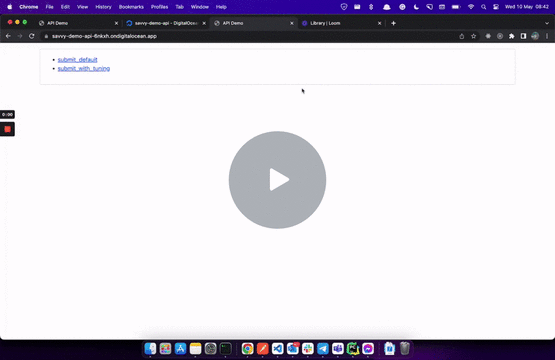Demo: Django API with client long-polling request to update status - Watch Video

URL: https://savvy-demo-api-6nkxh.ondigitalocean.app/
Username: demo
Password: demo@123
- Clone this repository and go to the project folder
- Create
.envfile with content like.env.example,.env.dockerfile with content like.env.docker.example,.env.postgresqlfile with content like.env.postgresql.example
cp .env.example .env
cp .env.docker.example .env.docker
cp .env.postgresql.example .env.postgresql- Build docker image and run docker container
docker-compose build
docker-compose up- Access to the
webcontainer and runpython manage.py migrateto migrate database - Access to the
webcontainer and create a new user with commandpython manage.py createsuperuser - Open
http://localhost:8000and login with the user you just created
Assume that each item in loop need 2 seconds to process by creating the function long_run_process in the Item model.
@classmethod
def long_run_process(cls, name, description):
"""A method that simulates a long-running process
"""
time.sleep(2)
instance = cls.objects.create(name=name, description=description)
return instanceWe solve the problem by:
- Use Celery to process the long-running task asynchronously
- Use the Task model to track the progress of the long-running task
- Create 2 APIs (using Django Rest Framework): one for main request and one for getting the status of the long-running task
Task model has fields for tracking the progress of the task and has user field to protect server against users submitting parallel requests. See the Task model in sample/models.py for more details.
POST api/tuned-long-running-task/ to receive the request data, create a task record for this request, send the long-running progress to Celery, then response the task id.
@api_view(['POST'])
@authentication_classes([SessionAuthentication, BasicAuthentication])
@permission_classes([IsAuthenticated])
@one_active_request_only
def long_running_task_with_tuning(request, format=None):
"""
Long-running task with some tuning
"""
serializer = WorkRequestDataSerializer(data=request.data)
if not serializer.is_valid():
return Response(
status=status.HTTP_400_BAD_REQUEST,
data={
'success': False,
'message': serializer.errors
}
)
# Create a task to track the progress of the long-running request
task = Task.objects.create(
user=request.user,
number_of_items=serializer.validated_data['number_of_items']
)
process_long_running_task.delay(
number_of_items=serializer.validated_data['number_of_items'],
task_id=task.id
)
return Response(
status=status.HTTP_200_OK,
data={
'success': True,
'data': {
'task_id': task.id,
'task_status': task.status,
}
})We also write a decorator for this API to protect server against users submitting parallel requests (only one active request at a time).
def one_active_request_only(function):
"""A decorator that prevents a user from sending multiple requests at the same time
"""
def wrap(request, *args, **kwargs):
task = Task.objects.filter(
user=request.user,
status__in=['QUEUED', 'PROCESSING'],
created_at__gt=timezone.now() - timedelta(minutes=5)
) # Check if there is an active request. The logic here depends on the business requirement
if not task:
return function(request, *args, **kwargs)
else:
return Response(
status=status.HTTP_201_CREATED,
data={
'success': True,
'message': 'There is an active request',
'data': {
'task_id': task.first().id,
}
}
)
wrap.__doc__ = function.__doc__
wrap.__name__ = function.__name__
return wrapIn the Celery, we update the status of the task when each item is processed. If all items are processed, we update the status of the task to SUCCESS.
@shared_task()
def process_long_running_task(number_of_items, task_id):
""" Process a long-running task
"""
Task.objects.filter(id=task_id).update(status='PROCESSING')
for i in range(number_of_items):
Item.long_run_process(name=f'Item {i}', description=f'Description {i}')
Task.objects.filter(id=task_id).update(count_done_items=i + 1)
Task.objects.filter(id=task_id).update(status='SUCCESS')
return TrueGET api/tuned-long-running-task/<task_id>/ to get the status of a task by task id.
@api_view(['GET'])
@authentication_classes([SessionAuthentication, BasicAuthentication])
@permission_classes([IsAuthenticated])
def get_long_running_task_status(request, task_id, format=None):
"""
A view that get status of a long-running task
"""
try:
task = Task.objects.get(id=task_id)
except Task.DoesNotExist:
return Response(
status=status.HTTP_404_NOT_FOUND,
data={
'success': False,
'message': 'Task not found'
},
)
return Response(
status=status.HTTP_200_OK,
data={
'success': True,
'data': {
'task_id': task.id,
'task_status': task.status,
'done_percentage': task.done_percentage(),
'count_done_items': task.count_done_items,
'number_of_items': task.number_of_items,
}
}
)It's separated into 2 parts:
- Send the main request and get the task id
- Get the status of the task by task id and update the progress indicator periodically
Users will be able to see that the request is processing. It makes a better user experience.
- Use
Django Channels(WebSocket) for updating the progress indicator in real-time - We could use Redis to store the task status instead of using the database
- The logic to check the uniqueness of the request could be changed by using hash function of request data. By this way, we could apply it for any requests we want to check.

